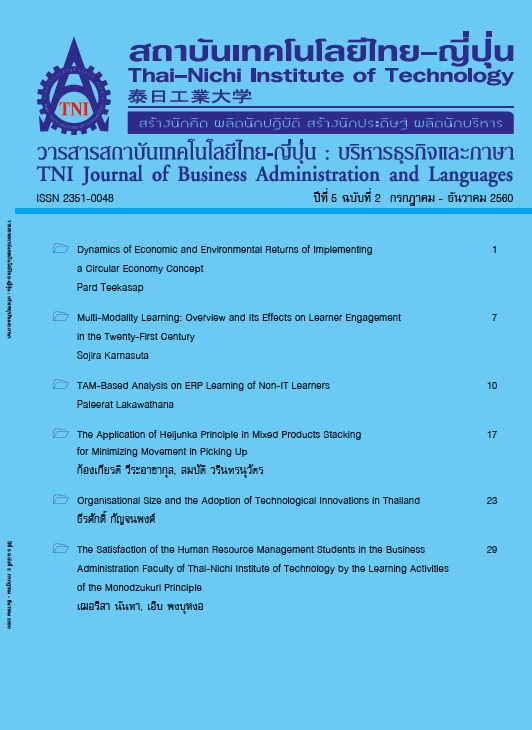Multi-Modality Learning: Overview and Its Effects on Learner Engagement in the Twenty-First Century
Main Article Content
Abstract
This study reviews the topic of multi-modality learning in this digital age, as well as examines the possibilities and limitations of its effect on student engagement and learning outcomes. Multimodal learning can be explained as the usage of several instructional methods in educating student; they are text, image, audio, or technology-enriched tool. Due to the increasing interest in incorporating multi-modality technique in teaching and learning, this review will include the following topics: theoretical definitions of multi-modality learning; background on multi-modality learning and methods; application and benefits of using multi-modality technology in various education fields such as language, science, medicine, and statistics; and its influences on student engagement and learning outcomes.
Article Details
Article Accepting Policy
The editorial board of Thai-Nichi Institute of Technology is pleased to receive articles from lecturers and experts in the fields of business administration, languages, engineering and technology written in Thai or English. The academic work submitted for publication must not be published in any other publication before and must not be under consideration of other journal submissions. Therefore, those interested in participating in the dissemination of work and knowledge can submit their article to the editorial board for further submission to the screening committee to consider publishing in the journal. The articles that can be published include solely research articles. Interested persons can prepare their articles by reviewing recommendations for article authors.
Copyright infringement is solely the responsibility of the author(s) of the article. Articles that have been published must be screened and reviewed for quality from qualified experts approved by the editorial board.
The text that appears within each article published in this research journal is a personal opinion of each author, nothing related to Thai-Nichi Institute of Technology, and other faculty members in the institution in any way. Responsibilities and accuracy for the content of each article are owned by each author. If there is any mistake, each author will be responsible for his/her own article(s).
The editorial board reserves the right not to bring any content, views or comments of articles in the Journal of Thai-Nichi Institute of Technology to publish before receiving permission from the authorized author(s) in writing. The published work is the copyright of the Journal of Thai-Nichi Institute of Technology.
References
L. Jiang and J. Luk, “Multimodal composing as a learning activity in English classrooms: inquiring into the sources of its motivational capacity,” System, vol. 59, pp. 1-11, Jul. 2016.
M. Gunel and F. Yesildag-Hasancebi, “Modal representations and their role in the learning process: a theoretical and pragmatic analysis,” Educational Sciences: Theory & Practice, vol. 16, pp. 109-126, Feb. 2016.
S. Norris, Analyzing Multimodal Interaction a methodological framework, Oxon, UK: Routledge, 2004.
A. Bourelle, T. Bourelle, A. V. Knutson, and S. Spong, “Sites of multimodal literacy: comparing student learning in online and face-to-face environments,” Computers and Composition, vol. 39, pp. 55-70, 2016.
S. Vungthong, E. Djonov, and J. Torr, “Images as a resource for supporting vocabulary learning: a multimodal analysis of Thai EFL tablet apps for primary school children,” TESOL QUARTERLY, vol. 51, no. 1, Mar. 2017.
F. L. Claman, “The impact of multiuser virtual environments on student engagement,” Nurse Education in Practice, vol. 15, pp. 13-16, 2015.
F. Kuo, P. Yu, and W. Hsiao, “Develop and evaluate the effects of multimodal presentation system on elementary student learning effectiveness: within classroom English learning activity,” Procedia – Social and Behavioral Sciences, vol. 176, pp. 227-235, Feb. 2015.
Z. I. Abrams, “Possibilities and challenges of learning German in a multimodal environment: A case study,” ReCALL, vol. 28, no. 3, pp. 343–363, Sep. 2016.
B. Gorjian, A. Hayati, and E. Barazandeh, “An evaluation of the effects of art on vocabulary learning through multi-sensory modalities,” Procedia Technology, vol. 1 (2012), pp. 345-350, 2012.
J. Chen, “The crossroads of English language learners, task-based instruction, and 3D multi-user virtual learning in Second Life,” Computers & Education, vol. 102, pp. 152-171, Nov. 2016.
J. Taljaard, “A review of multi-sensory technologies in a Science, Technology, Engineering, Arts and Mathematics (STEAM) classroom,” Journal of Learning Design, vol. 9, no. 2, pp.46-55, 2016.
W. Huang, S. Zeng, M. Wan, and G. Chen, “Medical media analytics via ranking and big learning: a multi-modality image-based disease severity prediction study,” Neurocomputing, vol. 204, pp. 125-134, Sep. 2016.
X. Yin, Y. Zhang, J. Cao, J. Wu, and S. Hadjiloucas, “Exploring the complementarity of THz pulse imaging and DCE-MRIs: toward a unified multi-channel classification and a deep learning framework,” Computer Methods and Programs in Biomedicine, vol. 137, pp. 87-114, Dec. 2016.
H. Wen, Y. Liu, I. Rekik, S. Wang, Z. Chen, J. Zhang, Y. Zhang, Y. Peng, and H. He, “Multi-modal multiple kernel learning for accurate identification of Tourette syndrome children,” Pattern Recognition, vol. 63, pp. 601-611, Mar. 2017.
Z. Zhu, Y. Chai, H. Yin, Y. Li, and Z. Liu, “A novel dictionary learning approach for multi-modality medical image fusion,” Neurocomputing, vol. 214, pp. 471-482, Nov. 2016.
A. Gynne and S. Bagga-Gupta, “Languaging in the twenty-first century: exploring varieties and modalities in literacies inside and outside learning spaces,” Language and Education, 29:6, pp. 509-526, Jun. 2015.
K. Lee and B. Kim, “Cross space: the exploration of SNS-based writing activities in a multimodal learning environment,” Educational Technology & Society, vol. 19(2), pp. 57-76, 2016.


